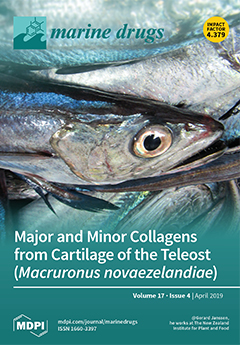A previous report indicated that collagen hydrolysate fraction (F7) from Spanish mackerel (
Scomberomorous niphonius) skins showed high reducing power and radical scavenging activities on 2,2-Diphenyl-1-picrylhydrazyl (DPPH) (EC
50 value of 1.57 mg/mL) and hydroxyl (EC
50 value of 1.20 mg/mL). In this work, eight peptides were isolated from F7 and identified as Gly-Pro-Tyr (GPY, 335.31 Da), Gly-Pro-Thr-Gly-Glu (GPTGE, 459.47 Da), Pro-Phe-Gly-Pro-Asp (PFGPD, 531.52 Da), Gly-Pro-Thr-Gly-Ala-Lys (GPTGAKG, 586.65 Da), Pro-Tyr-Gly-Ala-Lys-Gly (PYGAKG, 591.69 Da), Gly-Ala-Thr-Gly-Pro-Gln-Gly (GATGPQG, 586.61 Da), Gly-Pro-Phe-Gly-Pro-Met (GPFGPM, 604.73 Da), and Tyr-Gly-Pro-Met (YGPM, 466.50 Da), respectively. Among them, PFGPD, PYGAKG, and YGPM exhibited strong radical scavenging activities on DPPH (EC
50 values of 0.80, 3.02, and 0.72 mg/mL for PFGPD, PYGAKG, and YGPM, respectively), hydroxyl (EC
50 values of 0.81, 0.66, and 0.88 mg/mL for PFGPD, PYGAKG, and YGPM, respectively), superoxide anion (EC
50 values of 0.91, 0.80, and 0.73 mg/mL for PFGPD, PYGAKG, and YGPM, respectively), and 2,2′-azino-bis(3-ethylbenzothiazoline-6-sulphonic acid) (ABTS) cation (EC
50 values of 0.86, 1.07, and 0.82 mg/mL for PFGPD, PYGAKG, and YGPM, respectively) in a positive concentration–activity relationship. Furthermore, PFGPD, PYGAKG, and YGPM could effectively reduce Fe
3+ to Fe
2+ and inhibit lipid peroxidation. Hence, eight collagen peptides from hydrolysate of Spanish mackerel skins might be served as antioxidant candidates for various industrial applications.
Full article






